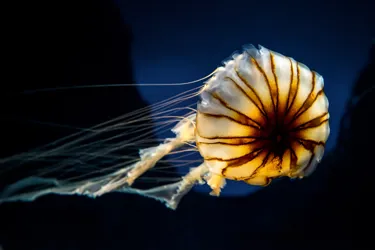7 Fun Facts You Didn't Know About Jellyfish
- Sunday 21st May 2017

Jellyfish are some of the ocean's most mesmerizing and mysterious creatures. With their translucent bodies and graceful movements, they captivate anyone who encounters them. But there's more to these sea dwellers than meets the eye! Dive in as we explore some fun and surprising facts about jellyfish.
1. The largest recorded jellyfish had tentacles over 120ft long!
The largest jellyfish known to man is the Lions Mane jellyfish. It has an average bell diameter of around 50cm but the largest specimens can be as big as 6ft in diameter with tentacles 100ft or more in length! The largest Lions Mane jellyfish recorded was found in Massachusetts. It had a bell diameter of 2.3m and its tentacles were 37m (121.4ft) long!
2. Jellyfish have no brain!
They also have no heart, bones or blood and are around 95% water! So how do they function without a brain or central nervous system? They have a basic set of nerves at the base of their tentacles which can detect touch, temperature, salinity etc. Since they don’t have a brain, they depend on automatic reflexes in response to these stimuli! Catching prey is also a matter of chance. They don’t actively hunt down their food; they just wait for prey to come in contact with their tentacles.
3. There are around 2000 known species of jellyfish!
There are more than 2000 different types of jellyfish, with many more still waiting to be discovered. Only approximately 70 of these species have stings strong enough to harm humans. Jellyfish are found in every ocean of the world, including around the UK!
4. Jellyfish have been around for approximately 650 million years!
Jellyfish have no bones so fossils are hard to come by, but scientists have evidence that these creatures have been bobbing along in the world’s oceans for around 650 million years or even longer. That means they pre-date the dinosaurs by hundreds of millions of years!
5. Jellyfish are a popular snack for the Leatherback Turtle!
Leatherback Turtles are known to follow groups of jellyfish in order to get a tasty meal, often bringing them close to coastlines like the UK. These turtles aren’t the only species to find jellyfish appetising; in some parts of the world humans also view jellyfish as a delicacy! The most common jellyfish chosen for this delicacy is the Cannonball jellyfish. While we don't have Leatherback Turtles at SEA LIFE, we have our very own Green Sea Turtles, Boris and Dougie, who you can meet in our Ocean Tunnel.
6. Jellyfish are not actually fish!
Jellyfish live mainly in the ocean but aren’t actually fish. They are plankton, and float in the water as they are carried by currents. They are members of the Cnidarian family, along with coral and anemones!
7. Jellyfish are taking over the oceans!
In recent years certain parts of the world have seen a problematic increase in jellyfish populations, called blooms. Scientists believe this is to do with additional nutrients in the water, climate change or fishing along the coastlines. Some researchers are concerned that the increased numbers of jellyfish could compete for food resources with fish and other marine animals, and eventually out-compete native local species. Jellyfish are one of the very few creatures that have been known to adapt to ocean dead zones, where there is little oxygen and lots of pollution.
Jellyfish are captivating creatures with a wealth of surprising traits. Their fascinating biology and unique abilities highlight the wonders of marine life. Discover them in our Ocean Invaders zone at SEA LIFE London.
Book your tickets and see what jellyfish we have at SEA LIFE London!
FAQs
Jellyfish do not have hearts, brains or blood! They have a basic set of nerves in their tentacles and depend on reflexes to respond to stimuli
There are around 2000 types of known jellyfish, with plenty more waiting to be discovered.